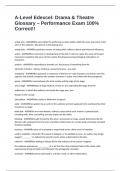A-Level Edexcel: Drama & Theatre
Glossary – Performance Exam 100%
Correct!!
acting area - ANSWERthe area within the performance space within which the actor may move in full
view of the audience. Also known as the playing area
acting style - ANSWERa particular manner of acting which reflects cultural and historical influences
action - ANSWERthe movement or development of the plot or story in a play; the sense of forward
movement created by the sense of time and/or the physical and psychological motivations of
characters.
analysis - ANSWERin responding to dramatic art, the process of examining how the
elements of drama—literary, technical, and performance—are used
antagonist - ANSWERthe opponent or adversary of the hero or main character of a drama; one who
opposes and actively competes with another character in a play, most often with the protagonist
apron - ANSWERthe area between the front curtain and the edge of the stage.
arena stage - ANSWERtype of stage without a frame or arch separating the stage from the
auditorium, in which the audience surrounds the stage area. (see
theatre-in-the-round)
articulation - ANSWERthe clarity or distinction of speech
aside - ANSWERlines spoken by an actor to the audience and not supposed to be overheard by other
characters on-stage.
black box - ANSWERa one-room theatre, without a proscenium arch; interior is painted black,
including walls, floor, and ceiling, and any drapes are also black.
blocking - ANSWERthe path formed by the actor's movement on stage, usually determined by the
director with assistance from the actor and often written down in a script using commonly accepted
theatrical symbols.
business - ANSWERa piece of unscripted or improvised action, often comic in intention,
used to establish a character, fill a pause in dialogue, or to establish a scene. An author may simply
suggest '________' to indicate the need for some action at that point in the play.
catharsis - ANSWERthe feeling of release felt by the audience at the end of a tragedy;
the audience experiences _________, or is set free from the emotional hold of the action, after
experiencing strong emotions and sharing in the protagonist's troubles.
character - ANSWERa person portrayed in a drama, novel, or other artistic piece.
, characterisation - ANSWERhow an actor uses body, voice, and thought to develop and portray a
character.
choreography - ANSWERthe movement of actors and dancers to music in a play.
chorus - ANSWERa group of performers who sing, dance, or recite in unison; in Greek drama, the
chorus was the group of performers who sang and danced between episodes, narrated off-stage
action, and commented on events.
climax - ANSWERthe point of greatest intensity in a series or progression of events in
a play, often forming the turning point of the plot and leading to some kind of resolution.
comedy - ANSWERa play that treats characters and situations in a humorous way. In
Shakespeare's time, a _____ was any play with a happy ending
that typically told the story of a likable character's rise to fortune.
In ancient Greece, comedies dealt almost exclusively with
contemporary figures and problems. Low _____ is physical rather
than intellectual _____; high _____ is more sophisticated,
emphasizing verbal with more than physical action.
comic relief - ANSWERa break in the tension of a tragedy provided by a comic character, a comic
episode, or even a comic line.
concentration - ANSWERthe actor's focus, also called centering; focusing on the work at hand, being
in character, or being in the moment.
conflict - ANSWERthe internal or external struggle between opposing forces, ideas, or interests that
creates dramatic tension.
contrast - ANSWERdynamic use of opposites, such as movement/stillness, sound/silence, and
light/darkness.
dénouement - ANSWERthe moment in a drama when the essential plot point is unravelled or
explained.
development - ANSWERprogression of the plot or conflict in a play.
dialogue - ANSWERspoken conversation used by two or more characters to express thoughts,
feelings, and actions.
dynamic - ANSWERthe energetic range of or variations within physical movement or the difference
between levels of sound
end on - ANSWERTraditional audience seating layout where the audience is looking at the stage from
the same direction. This seating layout is that of a Proscenium Arch theatre. (see also THRUST, IN THE
ROUND, TRAVERSE)
ensemble - ANSWERthe dynamic interaction and harmonious blending of the efforts of the many
artists involved in the dramatic activity of theatrical production.




